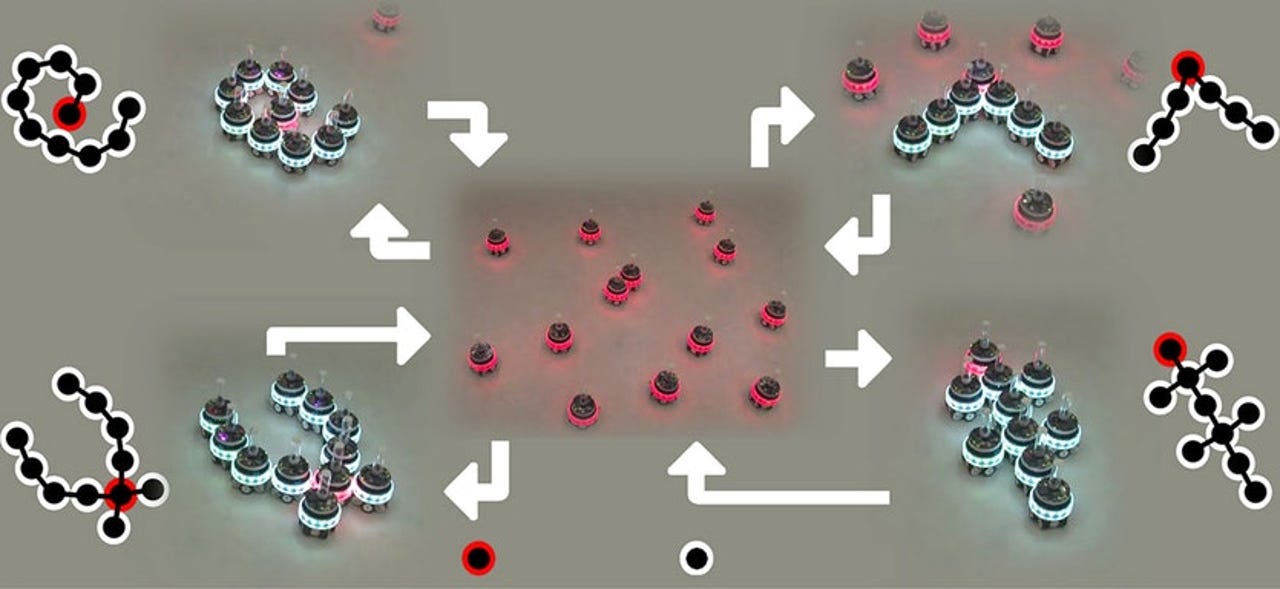Robots elect leader and join forces to create a larger robot


A team from the Free University of Brussels has made a robot capable of working together with its siblings to make a larger robot.
I know, I know. The reference is on the tip of your tongue, so let's just put it out there: The age of Voltron, the earth-defending robot made up of smaller tiger robots, is nigh.
In order to accomplish the task, the robots must collaborate autonomously and elect one of their own as a leader. Once combined, the merged robots actually share the equivalent of a single brain and a single robotic nervous system.
"By adopting a modular approach, robots with different capabilities, shapes, and sizes could, in theory, construct and reconfigure themselves as required," say the authors of the paper on mergeable robots published in Nature Communications.
It's a step forward for swarm robotics, a field in which multiple autonomous systems act in cooperation with one another. The effect is often achieved with a minimum of programmed instructions, mimicking the powerful-yet-elegantly simple rules that govern swarm behavior in flocks of birds or schools of fish.
For instance, researchers at Harvard's School of Engineering and Applied Sciences programmed over 1000 "Kilobots" to move in unison and make patterns and shapes.
Controversially, swarms are being looked at in military applications, where dozens or hundreds of small unmanned systems working in unison would be extremely difficult to thwart. But other applications are more promising. It's easy to imagine swarms of carpenter ant-like robots building houses quickly and cheaply, for example.
"Biological collectives involve enormous numbers of cooperating entities -- whether you think of cells or insects or animals -- that together accomplish a single task that is a magnitude beyond the scale of any individual," according to Dr. Michael Rubenstein, who worked on the Kilobot project as a Harvard fellow.
Read also: China is poised to dominate robotics markets sooner than expected | This roving robot learned pedestrian manners | Robotics in business: Everything humans need to know | Video of man getting beaned by robot demonstrates need for novel safety mechanisms
The University of Brussels team has taken swarm robotics to a new level by creating robots that physically link up to accomplish a task that the individuals could not. The big problem the researchers had to overcome was how a collective of systems would be controlled once they were operating as a single entity.
The answer they hit upon was to program the robots to hand over control to one of their siblings once they link up.
"The robots we present can merge to form larger bodies with a single centralized controller, split into separate bodies with independent controllers, and self-heal by removing or replacing malfunctioning body parts," write the authors of the study. "This work takes us closer to robots that can autonomously change their size, form and function."
The video makes it clear that we're not exactly on the cusp of Voltron days. But task-agnostic modules that can come together to form a huge number of possible machines does fundamentally change how we think about engineering problems and hardware design.
So, say it loud, say it proud: "Activate interlock! Dynotherms connected! Infracells up! Mega thrusters are go! LET'S GO VOLTRON FORCE!"
PREVIOUS AND RELATED COVERAGE
Watch this origami drone tackle a crucial problem with drone delivery
More proof that hardware is becoming increasingly elegant in the age of desktop prototyping.
UK bans fully autonomous weapons after Elon Musk letter
US and other superpowers remain vague on killer robots.
Fully autonomous drone maker takes aim at defense and homeland security
Backers are betting big on aerial automation for mining, refineries, and gas facilities. Security and defense are next.